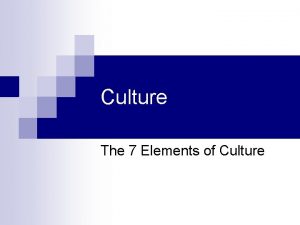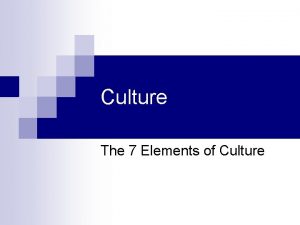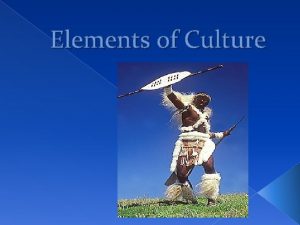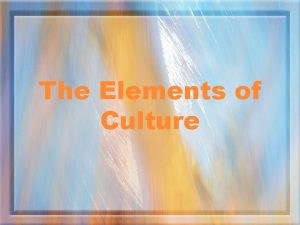CULTURE What is itreally ELEMENTS OF CULTURE v







- Slides: 7

CULTURE What is it…really?

ELEMENTS OF CULTURE v. Culture refers to a people’s way of life, how they meet their basic needs for food and shelter, their beliefs about the world and religion, music, art, and technology. v. Elements of Culture include: v. Language v Religion v Social Structure & Ethnic Groups v Customs v Family Structure & Gender Roles

LANGUAGE v. Language is a system of words and symbols people use to communicate with each other v. Includes full languages (English, French, Spanish), slang (Spanglish), and body language v. Language unites peoples from many different places on Earth. v Spanish is spoken on every habitable continent except Australia.

RELIGION v Religion is a set of beliefs about the meaning of life, the nature of the universe, and the existence of a God or Supreme Being. v. Includes customs and practices that are related to the worship of God or several Gods that set the rules for living a good life. v. Organizations like churches, temples, or mosques where religious practices are conducted. v. One of the most important aspects of culture.

SOCIAL STRUCTURE & ETHNIC GROUPS v. Social structures provide a way for members of a society to work together to meet needs. People are organized into different social classes when they share similar levels of wealth, power, and influence. Vary from culture to culture. v. Upper Class- earns or inherits wealth, owns large shares of property in society, luxurious lifestyles, often serve in leadership roles v. Middle & Working Class- educated, mostly successful people (managers, small business owners, professionals, shopkeepers). v. Peasant & Lower Class- labor workers and the unskilled/uneducated. v. Ethnic Groups – people that share a common language, history, place of origin v. Homogeneous societies- where everyone belongs to same ethnic group v. Multicultural societies- one dominant ethnic group and several minorities; ethnic groups are mixed throughout the country, certain groups sometimes stick to a specific region

CUSTOMS v Traditions and learned behaviors that people participate in, including: v. Clothing & Traditional Dress v. Food v. Rules for Behavior v. Customs also include how they celebrate holidays and rites of passage, such as: v. Births v. Coming of Age (Bat Mitzvahs, Quinceaneras, Sweet 16 s) v. Marriage v. Parenthood v. Death

FAMILY STRUCTURE & GENDER ROLES v. Family Structure- a support system in which there are positions that serve specific purposes for providing care for members (ex: mother, father, child, grandmother, uncle…) v. Gender Roles- social norms that dictate how people are expected to behave v. In advanced societies, gender roles are changing to represent modern social norms - both parents may work, men may provide child care, women work in influential business and political positions. v. In traditional societies, women are expected to stay at home and be accompanied by a male in public. Both men and women are expected to wear specific clothing, though women’s clothes are much more restrictive than mens.













